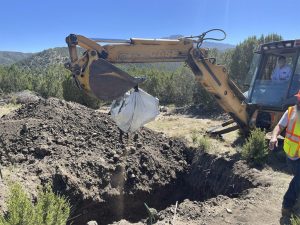Baking at Altitude
by Carol Dunn
HUERFANO- If you are new to this area, you may find that your favorite cookie, cake and bread recipes just don’t perform well. You can blame the altitude. Many recipes are developed to work best between sea level and 3500 feet. Higher altitudes present some problems to the baker: the air is drier, water boils at a lower temperature (about 198 degrees F in La Veta), leavening agents work faster, and liquids evaporate faster.
The flour in your recipes is drier here, so you will generally need to add more liquid. Baking powder and yeast will give off larger gas bubbles at altitude, causing your baked goods to expand too much, weakening the structure and causing finished baked goods to “fall” once removed from the oven. So you’ll need to compensate for the over-action of the leavening. Sugar and chocolate also weaken the structure of baked goods – that’s why sugary cookies look good in the oven but flatten out after they are done baking.
Suggested adjustments to low-altitude recipes:
The baking powder adjustment is by far the most important one. When called for, use cold liquid and cold eggs to help strengthen the structure. A little extra flour also helps the structure. You may want to try using a “high-altitude flour” for baking.
For cakes, increase oven temperature about 20 degrees (to set the crust), and decrease the baking time to compensate. Use the largest size pan recommended, and fill no more than half full. For cakes with a lot of shortening (one cup or more) use 1-2 T less shortening and add an egg to prevent the finished cake from falling.
Biscuits usually only need an adjustment to baking powder. Muffins benefit from a higher oven temperature and shorter baking time.
Cookies take some experimentation. If there is no liquid, add one or two T of flour. Reduce the baking powder and sugar for cake-like cookies. The longer you bake cookies, the more they dry out and harden, so try a shorter baking time.
Bread dough will need more liquid, and the rising time is shorter. Only allow yeast breads to rise until double in size. This can be as short as 50 minutes in La Veta, rather than the 1- 1 ½ hours some recipes call for. Spray the dough with cooking spray and cover with plastic wrap while rising to keep it from drying out.
Quick breads, like banana bread, may benefit from 2-4 T of extra flour and a higher baking temperature.
For more information on baking at high altitudes, go to: www.ext.colostate.edu/pubs/pubs.html#nutr_high, choose Nutrition, Health & Food Safety. There are several high altitude food preparation pamphlets available from CSU Cooperative Extension, including "High Altitude Food Preparation Guide," which is free and can be printed from a pdf file.
Once you experiment with these adjustments and get the correct proportions for your recipes, you’ll be able to enjoy your high altitude baking experience.




